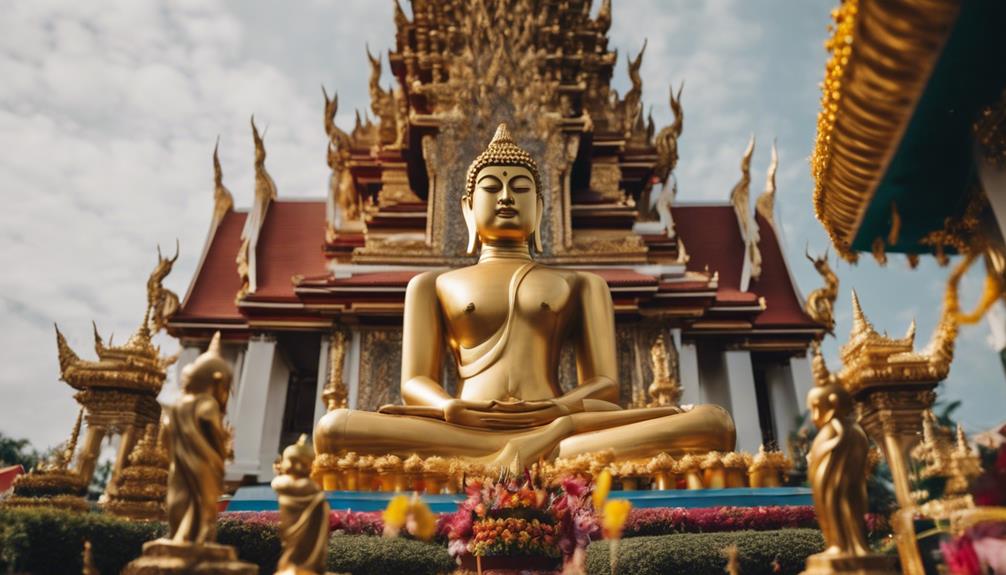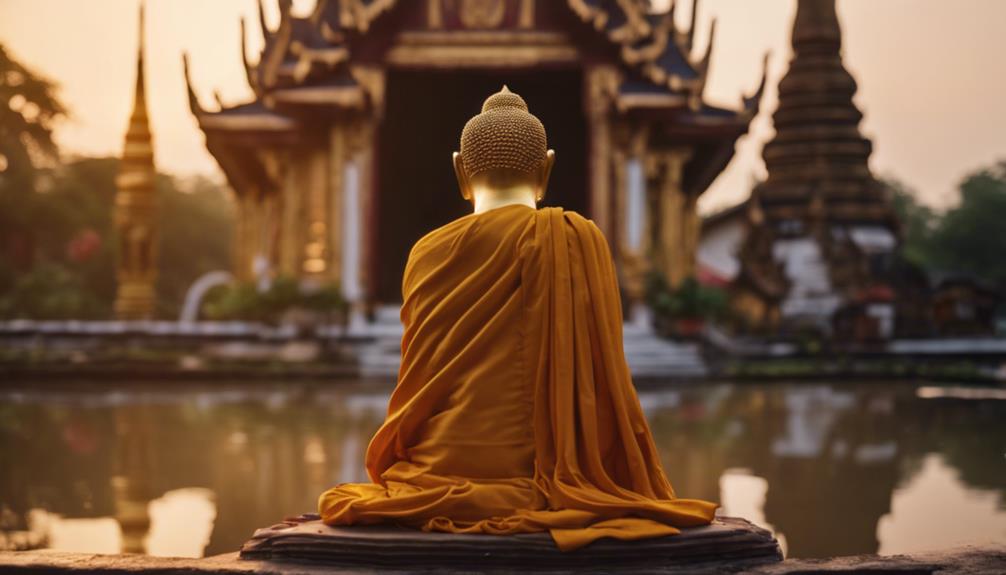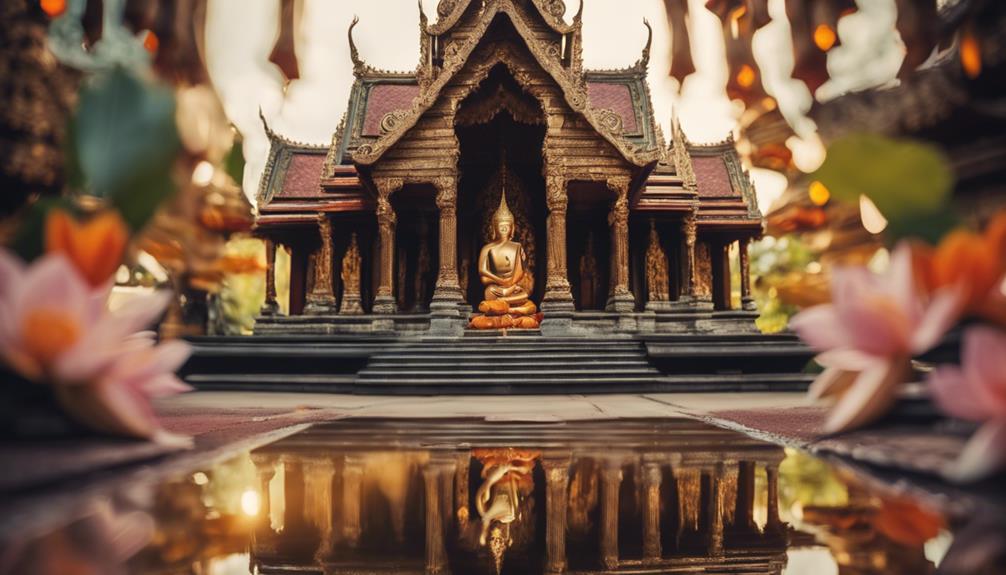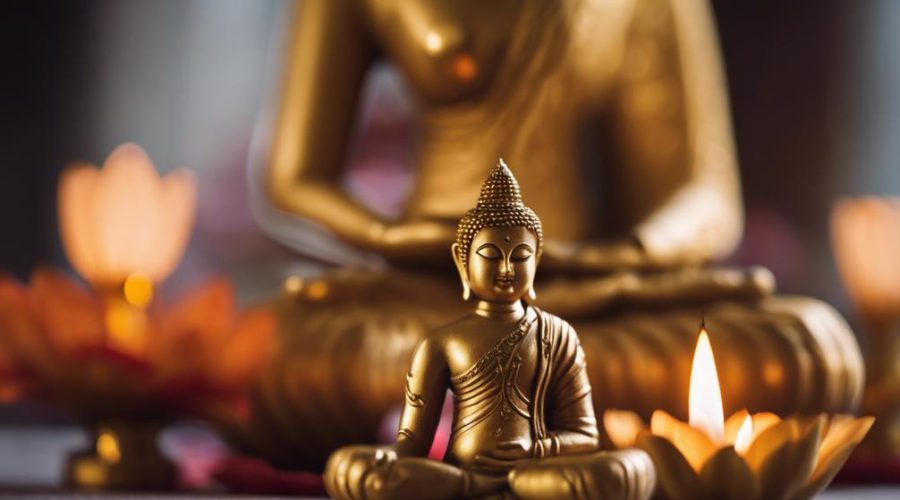Is Thailand Buddhism or Hinduism?
Thailand is primarily a Buddhist country, with approximately 95% of the population practicing Theravada Buddhism. However, you'll find a significant influence of Hinduism within Thai culture, art, customs, and mythology. This fusion presents a unique blend of these two religions, creating a rich cultural and religious landscape. Thai society offers an example of religious harmony, where Buddhist principles and Hindu practices seamlessly coexist and are deeply embedded in daily life. With this fascinating blend, there's a wealth of knowledge awaiting you about how Buddhism and Hinduism collectively shape the Thai identity.
Key Takeaways
- Thailand predominantly practices Buddhism, particularly Theravada Buddhism, which deeply influences Thai society and culture.
- Hinduism also impacts Thai culture, with many Thais seeking blessings from Hindu gods and incorporating Hindu rituals into their practices.
- Thai religion reflects a unique blend of Buddhist, Hindu, and indigenous spiritual practices, showcasing religious tolerance and cultural fluidity.
- Thai society is characterized by religious syncretism, with Buddhist teachings, Hindu rituals, and animistic traditions coexisting harmoniously.
- Festivals like Loy Krathong and the Vegetarian Festival demonstrate the fusion of Buddhist and Hindu elements in Thai culture.
Understanding Religious Landscape in Thailand

To fully understand the religious landscape of Thailand, one must explore the rich tapestry of beliefs that make up the majority of the country's spiritual practices. It's a colorful palette of diversity, where religious tolerance isn't merely preached but practiced. You'll see it in the seamless co-existence of Buddhism, Hinduism, and other minority religions.
Despite Buddhism's predominance, Thai society has always opened its arms to other faiths. It's an acceptance woven into the fabric of Thai culture, evident in the vibrant Thai festivals.
Consider the Loy Krathong festival, where you'll observe the blending of Buddhist and Hindu traditions. As you release a small boat, or 'krathong', into the water, you're partaking in a practice that honors both the Buddha and the Hindu goddess of water, Ganga.
Then there's the Vegetarian Festival, a Taoist celebration adopted by Thais. It's a demonstration of how this society absorbs different beliefs, integrating them into a unique, harmonious whole.
In Thailand, religious tolerance isn't a lofty ideal—it's a lived reality. The Thai's approach to religion offers a model that's innovative and adaptable, one that the rest of the world could learn from.
Historical Overview of Thai Religion
Delving into the historical panorama of Thai religion, you'll find that it's a complex tapestry woven over centuries, deeply influenced by the interplay of Buddhism, Hinduism, and indigenous spiritual practices. Importantly, religious syncretism has played a pivotal role in the Thai religious landscape, blending diverse beliefs into a unique spiritual amalgamation.
Undeniably, Thai mythology, with its vibrant pantheon of deities and spirits, reflects this blend. It pulls threads from both Buddhism and Hinduism, weaving them with local animistic traditions. You'll notice Hindu gods like Indra and Shiva comfortably co-existing alongside Buddhist figures such as the Buddha himself and Bodhisattvas.
Interestingly, this religious pluralism isn't merely a historical artifact, but an ongoing dynamic process. Thai religion has shown a remarkable capacity to absorb and integrate new influences, yet retaining its distinct character. This reflects a culture of innovation and adaptability.
Thus, Thai religion stands as a reflection of the nation's inclusive ethos and resilience, embracing change while preserving tradition. It's a thought-provoking study in contrast, a dance of the ancient and the modern, the local and the foreign, the sacred and the secular. This nuanced view of Thai religion allows for a deeper understanding of Thailand's spiritual identity.
Proliferation of Buddhism in Thailand

Exploring the proliferation of Buddhism in Thailand, you'll discover that it is the country's main religion, deeply ingrained in Thai society, culture, and daily life. Buddhism, particularly Theravada Buddhism, has shaped Thai identity, values, and norms for centuries.
Buddhist architecture and Thai monasticism are proud indications of the significant role of Buddhism. Take, for instance, the grand temples or 'wats' spread across Thailand. Their intricate designs reflect the essence of Buddhist philosophy, while Thai monasticism continues to be an important element of Thai society.
The table below presents a brief look at the influence of Buddhism in various aspects of Thai life.
| Aspect | Influence of Buddhism |
|---|---|
| Architecture | Buddhist temples or 'wats' dot the Thai landscape, showcasing the beautiful Thai-Buddhist architectural style. |
| Monasticism | Thai males are encouraged to become monks, embedding Buddhist teachings in societal fabric. |
| Culture | Buddhist principles guide Thai etiquette, customs, and festivals. |
| Education | Many Thai schools are affiliated with Buddhist temples, ensuring the teachings are part of the curriculum. |
Innovation in the interpretation and practice of Buddhism remains important for its enduring relevance and growth in Thai society. While respecting traditions, Thailand continually seeks new ways to express and apply Buddhist wisdom.
Influence of Hinduism on Thai Society
While Buddhism largely shapes the Thai landscape, you can't overlook the subtle yet profound influence of Hinduism on Thai society. Hinduism's impact permeates many aspects of Thai culture, most prominently in the worship of Hindu deities and the influence on Thai cuisine.
Many Thai people keep images of Hindu gods in their homes and businesses, seeking blessings and protection. This Hindu Deities Worship isn't seen as a confirmation to Buddhism, but rather as a complementary practice. It's a demonstration of how fluid and inclusive Thai religious beliefs can be.
The culinary scene in Thailand also bears traces of Hinduism. Thai Cuisine Influence from India can be seen in the use of spices and certain ingredients. The adoption of vegetarianism during certain religious periods is another Hindu practice that's found its way into Thai traditions.
In essence, although Buddhism is the dominant religion, the fingerprints of Hinduism are evident in Thai society's fabric. It's a fascinating blend that demonstrates the porous nature of cultural and religious boundaries, and an example of how societies can evolve and innovate while respecting and incorporating ancient traditions.
Buddhism-Hinduism Intersection in Thai Culture

Now, let's turn our attention to the fascinating intersection of Buddhism and Hinduism in Thai culture. This blending is apparent in various aspects of Thai life, particularly in Thai iconography and the use of sacred symbols.
| Buddhism in Thai Culture | Hinduism in Thai Culture |
|---|---|
| Theravada Buddhism is the state religion | Hindu gods are revered |
| Thai iconography heavily portrays Buddha | Deities like Brahma, Vishnu are depicted |
| Sacred symbols like the lotus are common | Sacred symbols include the Om, Swastika |
| Meditation is a key practice | Rituals and offerings play a significant role |
| Buddhist teachings influence daily life | Hindu epics are part of cultural performances |
You'll see that while Buddhism is the dominant religion, Hindu elements are interwoven seamlessly. Thai iconography is rich with images of Buddha, yet Hindu deities like Brahma and Vishnu are also commonly depicted in temples and artwork. Similarly, while sacred Buddhist symbols like the lotus are prevalent, Hindu symbols such as Om and Swastika can also be found. This synthesis results in a unique cultural fabric that is both distinct and harmonious, a reflection of Thailand's capacity for religious and cultural fusion.
Rituals and Practices: A Comparative Analysis
You'll now examine the rituals and practices within both Buddhism and Hinduism as they manifest in Thailand.
By first understanding the specificities of each, you can then draw comparisons to identify the shared and divergent aspects.
This comparative analysis will further illuminate the complex religious landscape of Thailand.
Buddhist Rituals in Thailand
Often, in Thailand, Buddhist rituals are performed, reflecting a deep intertwining of cultural practices and religious beliefs. This fusion is visible in Buddhist architecture, where intricate designs depict stories of Buddha's life, teachings, and monastic life. Temples, or 'wats', aren't merely places of worship but are symbolically structured to represent Buddhist cosmology.
Monastic life is integral to Thai Buddhism, with monks performing daily rituals and playing a pivotal role in community life. They lead ceremonies, provide spiritual guidance, and serve as a bridge between the divine and the ordinary. You'll observe rituals such as alms-giving, meditation, and chanting – practices ingrained in the daily life of Thais. These rituals reflect Buddhism's profound influence on Thai society's cultural fabric.
Hindu Practices in Thailand
While Buddhism is the primary religion in Thailand, a significant imprint of Hindu practices is also visible in the country's religious landscape. You'll find Hindu festivals in Thailand like Navaratri and Diwali celebrated with equal fervor as they're in India. These festivals reflect the cultural amalgamation and shared spiritual heritage of the two religions.
Moreover, Thai Hindu architecture is a confirmation of this influence. The intricate carvings and designs of temples, especially in Bangkok, are replete with Hindu motifs and iconography. They aren't just places of worship, but also sites of cross-cultural exchange and syncretism. Despite Buddhism's dominance, Hindu practices continue to shape Thailand's religious and cultural landscape in profound ways.
Comparing Ritualistic Similarities
Building on this coexistence of Hindu and Buddhist practices in Thailand, it's interesting to explore the ritualistic similarities in the ceremonies and traditions of these two religions. You'll find both use ritualistic symbolism as a tool for divine representation, a reflection of their shared heritage.
In Buddhist rituals, you'll see statues and images of Buddha, symbolizing aspects of his enlightenment. Similarly, in Hindu practices, deities like Shiva or Vishnu are represented in intricate idols, symbolizing their divine attributes. Both religions place great emphasis on these symbols during ceremonies, leveraging their power to invoke spiritual connection.
This comparative analysis highlights the profound influence both religions have on each other, fostering a unique blend of religious practices in Thailand.
Contemporary Thai Society: Coexistence of Both Religions
You'll find that contemporary Thai society reflects a fascinating coexistence of Buddhism and Hinduism.
Begin by examining Buddhism's extensive influence on Thailand.
Then shift your focus to the role Hinduism plays within the same context.
Buddhism's Influence on Thailand
In contemporary Thai society, you'll find a harmonious coexistence of Buddhism and Hinduism, with Buddhism exerting a noteworthy influence on various aspects of daily life and culture. Buddhist art, for instance, permeates Thai architecture, sculpture, and painting, serving as an aesthetic language of spiritual expression. This artistic influence imparts a serene ambiance that's distinctly Thai.
Furthermore, the system of monastic education, deeply rooted in Buddhism, substantially shapes the moral and social fabric of the society. It fosters a culture of mindfulness and introspection, cultivating values of non-violence, compassion, and self-discipline.
Thus, Buddhism doesn't just coexist with Hinduism in Thailand; it leaves lasting imprints on the nation's identity, a reflection of the adaptability and resilience of Thai culture.
Hinduism's Role in Thailand
While Buddhism may dominate the Thai religious landscape, it's Hinduism that subtly threads itself through the nation's culture and ceremonies, playing an essential role in shaping Thailand's rich history and diverse traditions.
You'll notice the Hindu deities in Thailand, present in royal rituals, dance dramas, and the arts. Thai Hindu festivals, too, showcase the vibrant interweaving of both faiths. To illustrate:
- The deity Brahma's statue graces many Thai businesses.
- Thai classical dance borrows heavily from Indian Ramayana.
- Ganesha, known as Phra Phikanet, is a symbol of success.
- The Royal Ploughing Ceremony honours Hindu gods of agriculture.
- The annual Navaratri festival celebrates the victory of good over evil.
These examples underscore Hinduism's role in Thailand's contemporary society, innovatively merging with local customs to create a unique cultural blend.
Interplay of Buddhism and Hinduism
Despite the predominant Buddhist faith, you'll find Hindu influences deeply embedded in contemporary Thai society, reflecting a harmonious coexistence of both religions. This intermingling is a prime example of religious syncretism, showcasing Thailand's cultural fluidity and resilience. Comparative theology helps to decipher the cross-pollination of beliefs, where Buddhist teachings are intertwined with Hindu gods and rituals, creating a unique fusion that shapes Thai spirituality.
This amalgamation not only enriches the religious diversity but also fosters tolerance and mutual respect. In an era craving innovation, this model of religious harmony in Thailand could serve as an exemplar for societies grappling with religious pluralism. The Thai experience illustrates that diverse religious beliefs can coexist peacefully and even enhance each other, contributing to societal unity and progression.
Future Outlook: Buddhism and Hinduism in Thailand
Looking ahead, it's evident that both Buddhism and Hinduism continue to shape Thailand's cultural, social, and spiritual landscapes, often interweaving to yield a unique religious tapestry. With religious tolerance as a cornerstone, Thailand has become a hub for religious tourism, attracting people globally to its sacred Buddhist and Hindu sites.
The future of these religions in Thailand may revolve around a few key factors:
- The state's ongoing commitment to religious freedom, promoting peaceful coexistence
- The enhancement of religious tourism, attracting global tourists to Thailand's temples and religious festivals
- The continued integration of Buddhist and Hindu rituals in Thai culture, strengthening the nation's unique religious identity
- The digital transformation of religious practices, encompassing online sermons and virtual temples
- The evolving role of women in religious practices, challenging traditional norms and promoting inclusivity
The interplay of Buddhism and Hinduism has fashioned a distinctive religious identity for Thailand. With the country's commitment to religious tolerance and the burgeoning field of religious tourism, the future of these religions appears to be deeply ingrained in Thailand's evolving cultural tapestry.



